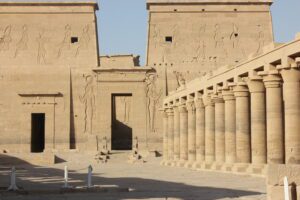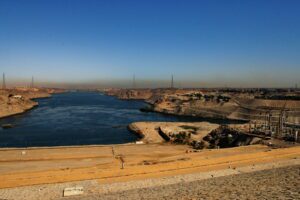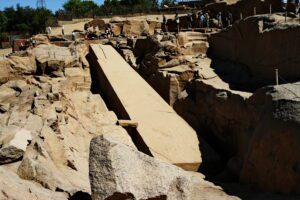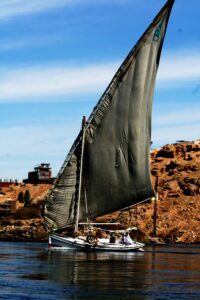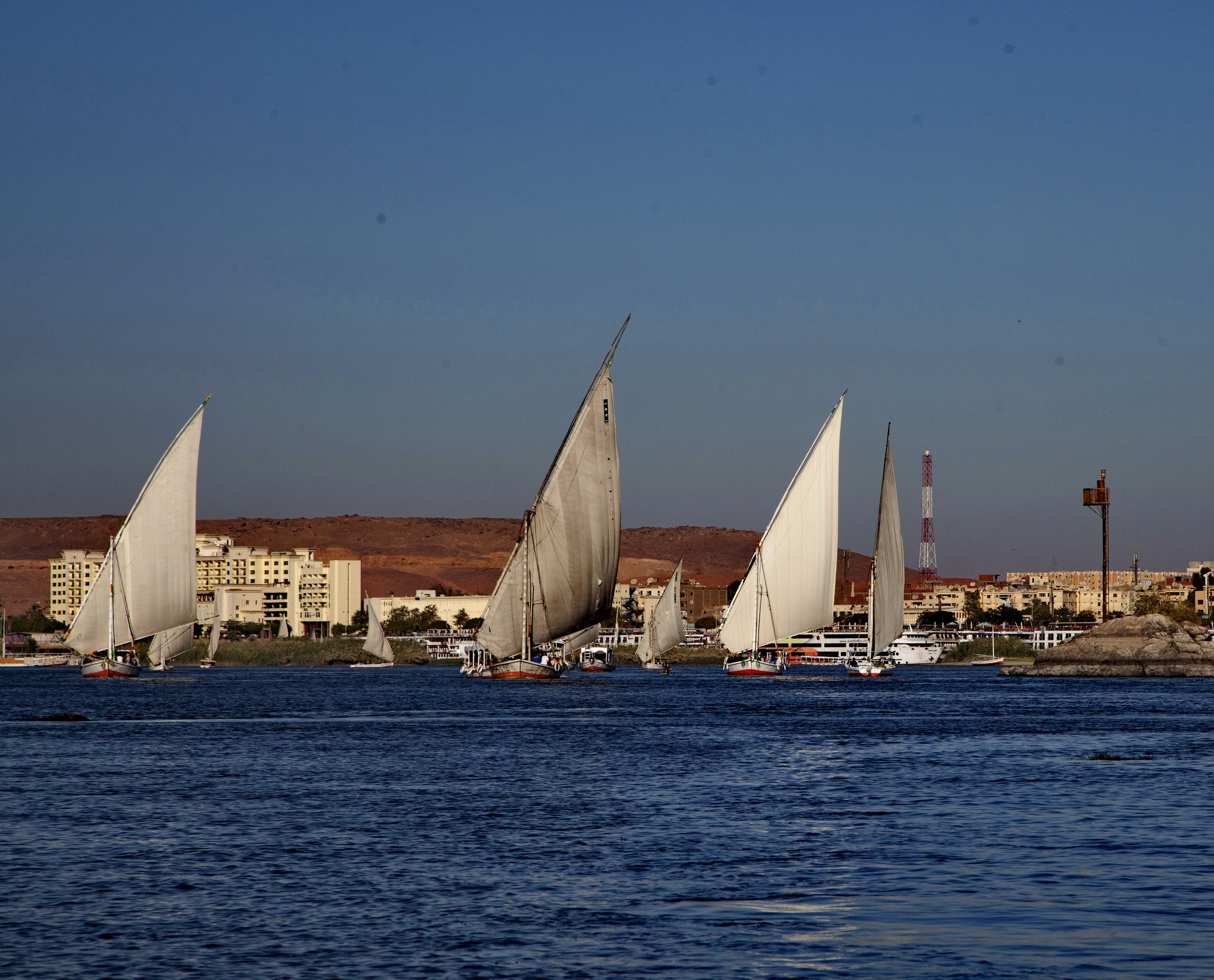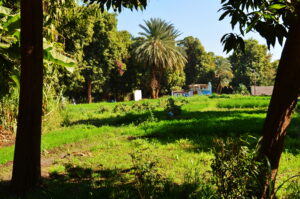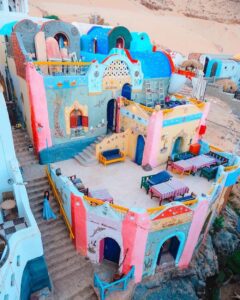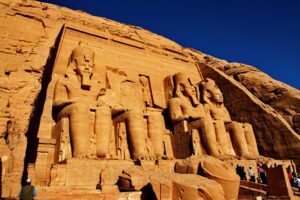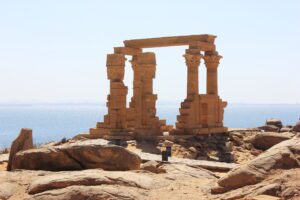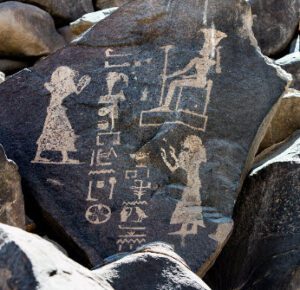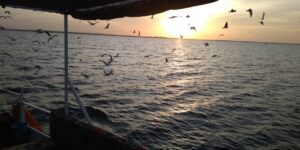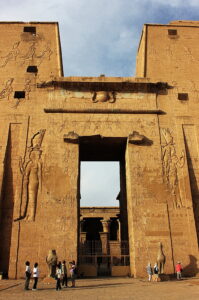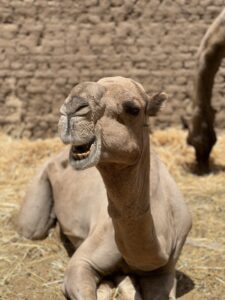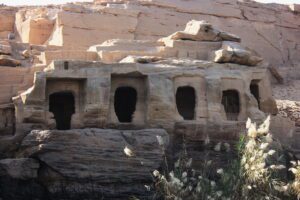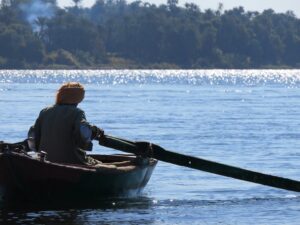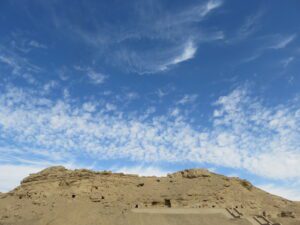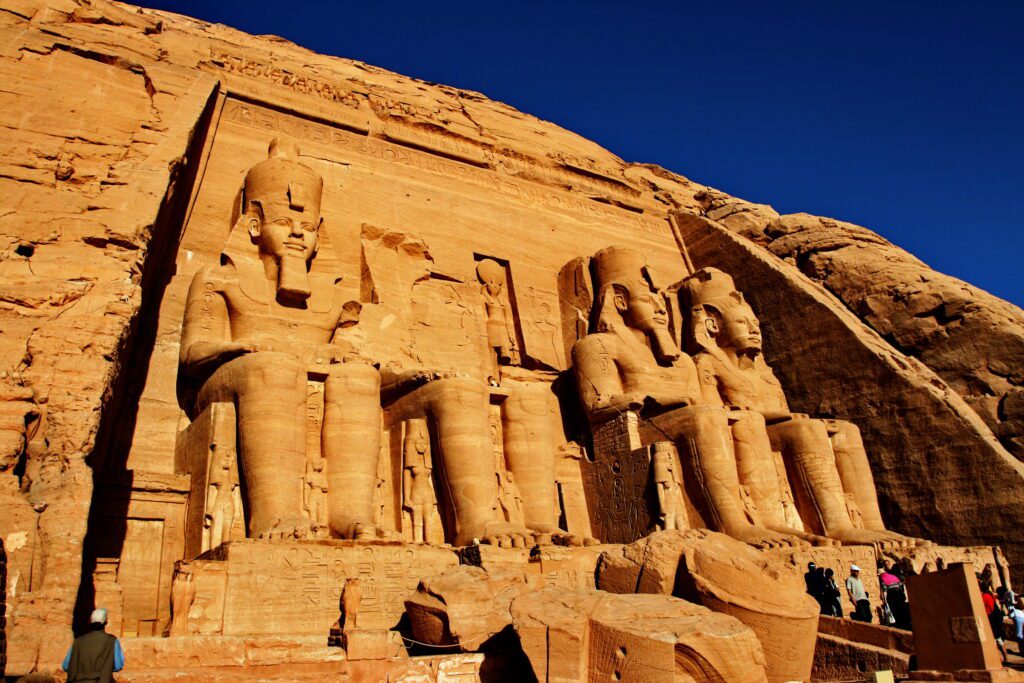
Aswan and Nubia
Aswan, formerly known as Swenett, is a delightful city in southern Egypt. The name Aswan is derived from the ancient Egyptian word “Soun”, which means “market” or “souk.” Aswan got its name from being a strategic gateway to the south. It was the primary source of granite used for obelisks and sculptures in ancient times. Aswan is well-known for its stunning Nile Valley scenery, significant archaeological sites, and serene atmosphere. Its weather is mild all year, making it an ideal winter destination.
The city offers spectacular views and attractions for felucca sailing on the Nile (Egyptian sailboat). The river flows gently from Lake Nasser, passing through several islands surrounded by black granite and greenery.
Aswan has many significant archaeological sites close to the modern city, which can be reached by smaller boats or by land, and is also your first step to sites in the far South, including the temples of Philae and Kalabsha and, with a longer drive, the temples of Abu Simbel. For those interested in more recent construction and how the changing flow of the Nile has influenced Egyptian history through to today, the High Dam can be visited on the trip to Abu Simbel.
If you have time only for sightseeing closer to the city, the Nubian Museum and the Unfinished Obelisk give you further insights into the multifaceted history of this area and into how monuments and edifices were made.
Aswan’s Nubian culture is an aspect of Egypt that everyone should have an introduction to. We can walk through the villages and also visit the Animalia House Museum, which is an excellent place to learn about the Nubian culture and the changes that came about with the building of the High Dam.
There are other leisurely ways to explore Aswan that we can include, from a visit to the souq to sandboarding.
Aswan & Nubia
- Philae TempleWe take a boat to the island, giving you a picturesque approach to the site. During the 1960s, the monuments on this island were relocated from the original Philae island so they would not be flooded due to the construction of the Aswan High Dam. Philae includes many structures, mostly dating to the Ptolemaic era (332–30 BC). The most prominent of these is a temple dedicated to Isis, begun by Ptolemy II Philadelphus. This temple was one of the last ancient Egyptian temples to remain active until Emperor Justinian I (527–565 AD) ordered the closure of all non-Christian temples. The temple was converted into a Christian church. There also is a temple dedicated to Hathor built by Ptolemy VI Philometor (180–145 BC) and emperor Augustus of Rome (30 BC–14 AD) and the elegant Kiosk of Trajan (98–117 AD). Note: most tours include Philae, which we visit during the day, but some include the sound and light show in the evening. See your chosen itinerary for your time of visit. Philae Sound and Light show If you are are in Aswan then The Sound and Light show at Philae is a must. The mythology of Egypt contains some of the most well-known legends in the world, and in this show at Philae, they are brought to life in a memorable and mesmerizing way to draw in all those who witness it. The history of Philae and the legend of Osiris are displayed through dazzling lights and capturing music, with each note and flash pulling out the ancient history which was the base of Ancient Egyptian culture. Watch as the Egyptian deities are resurrected to tell their tales, the past coming to life before your eyes, the temple jumping to life around you. This show brings history and the past to life, resurrecting The Myth of Osiris, The God of the Dead, and Isis, his beloved wife and the Goddess of Magic, as she brought him back to life after his brother, Seth, God of Evil, murdered him. Behold, as Ancient Egypt’s stories grace the Philae Temples, Lights, sounds and haunting voices make it all seem very real.

- High DamVisiting the dam and lake adds to your understanding of how the changing flow of the Nile has influenced Egyptian history. The dam height is 111 meters (364 feet) and the length is 3,830 meters (12,565.5 feet), with a width at the base of 980 metres (3,215 feet). The capacity of the lake is 132 cubic km (31.5 cubic miles) and its surface area is 5,250 square km (2,027 square miles), making it an impressive sight in itself. The dam was built to control the flooding of the Nile, increase water storage for irrigation, and generate hydroelectricity. While the annual Nile floods make land along the river more fertile, their variability could also result in crop failure. With substantial growth in the population, controlling the impact of the Nile on agriculture has become increasingly important for the security of food and cotton crops. The plan to build the dam was controversial because it would flood the lands of the Nubian people and cover the remains of previous societies, including several important ancient Egyptian temples. Plans to build a dam near Aswan were made as early as the 11th century, but it was long considered too difficult. Construction of the first dam was begun by the British in 1898 and it was opened in 1902. The push to build the high dam began following the 1952 revolution, in line with plans to increase industrialization in Egypt. Political jousting between Egypt and the USA, UK, and Russia over arms deals and Egypt’s recognition of China saw potential funding for the dam from the USA and UK refused. Eventually, Russia offered a low-interest loan for the construction, and the Moscow-based Hydroproject Institute and Egyptian engineers designed the dam. As construction of the dam began in 1960, a rescue operation also began under UNESCO. Abu Simbel was moved so it would not disappear beneath the waters of the lake created by the dam, an extraordinary feat of engineering. In 1964, after completion of the first stage, the filling of the reservoir commenced. In 1970, the High Dam was completed, and in 1976, the reservoir reached capacity. The dam brought relief from floods and drought, and increased agricultural production, employment, and hydro-electricity. However, the large area flooded caused the relocation of more than 100,000 people, and these people still look back in sadness at the loss of their homes and the land of their cultural traditions. Many archaeological sites were submerged. Coastline erosion, soil salinity, and health problems have also been associated with the changes the dam brought. The dam remains controversial because of these costs, many of them intangible costs to communities and the environment rather than financially measurable costs.

- Unfinished ObeliskThe term obelisk refers to four-sided, tapered monuments which were called tekhenu by the Ancient Egyptians. The term obelisks comes from the Greek word obeliskos (diminutive of obelos-a spit). More than half of the remaining ancient obelisks are outside of Egypt, having been prized by other civilizations, including the Romans (13 are located in Italy). The Roman emperor Augustus first used the obelisk as proof to the Roman people that Egypt had been conquered, and subsequent emperors continued this practice. There is an ongoing debate about who commissioned the obelisk. It is sometimes attributed to Hatshepsut, but more likely was built by the Kushite king Taharqa (690 to 664 BC) or by Nectanebo II (360–342 BC or 380 – 362 BC). It was destined to match the first pylon gate at Karnak temple, which is a similar height (the north tower is about 21.7 meters (71 feet) and the south 31.65 meters (104 feet); if it had been completed it would probably have been between 38 and 40 meters (124.5 and 131 feet). It is estimated that the unfinished obelisk would have measured 42 meters (138 feet) and weighed 1088.5 tonnes (1200 ton), which would have made it the largest obelisk constructed by the ancient Egyptians. It was left unfinished, possibly due to political instability or the Persian invasion. The site has taught us about the innovative methods and the tools used to carve out obelisks and free them from the surrounding stone, including the use of small balls made of dolerite, which is harder than granite, and some of these balls can still be found around the site.

- The Nile CataractThe perfect location for a boat ride is around Nubia just south of Aswan. The Nile River passes through formations of hard igneous rock for around 5 km (3 miles), resulting in a series of rapids, or cataracts. In Ancient Times it was credited as being the source of The Nile. The Nile cataracts provide beautiful scenery as well as exotic birds, such as The Kingfisher and Black Ibis, making it an ideal spot for photographers and nature lovers. The cataracts are rocky areas of boulders in the narrow channels of the River Nile which until a century or so ago, before the construction of the Old Aswan Dam in 1902, formed treacherous rapids of foaming water, making it dangerous to row between the rocks. Larger vessels were forced to unload their cargo in order to negotiate this stretch of river. Standing on top of the hill overlooking the Nile River gives us a good idea of how hazardous the river journey would have been and why the traveller would have felt in need of divine protection. We can stop on the West Bank, with a small climb to the top of a sand dune, which is the best place to view the granite island, The Blue Nile, and the Golden Desert. It is advised that, when exploring The Cataract, you take a small motorboat with an expert sailor for the best experience.

- Kitchener Island (Botanical Gardens)Kitchener Island, also known as Aswan Botanical Island, was given to Lord Horatio Kitchener in the 1890s when he was commander of the Egyptian army. Indulging his passion for exotic flora, beautiful palms, and plants, Kitchener turned the entire island into a stunning botanical garden, importing plants, shrubs, and seeds from all over the world and on the top of that, offers a great view over the Nile River and the West Bank charming sand dunes. From Kitchener Island, you can have a wonderful view over The Nile Valley, where you can see the contrast of the Bluewater of The Nile, the lush green of The Nile Valley, and The Golden Sand Dunes of the desert, all in one picture. The Island covers 6.8 hectares and is filled with exotic birds and hundreds of species of flora, making it a photographer and nature lover’s paradise. Today this island-wide botanical garden has a natural wild feeling to it and is a wonderful place to relax, with birdlife, butterflies, and stately palms suffused with the aroma of sandalwood for an hour before sunset. An Island picnic is a wonderful relaxing few hours. A small museum is also on the island, a wonderful way to spend a couple of hours learning about the different plants and trees from around the world all in Aswan.

- Elephantine Nubian IslandElephantine Island Archaeological Site This archaeological site is one of the most unique in upper Egypt because here you can see across 4,000 years of Egypt’s history, from 3,000 BC until late Medieval times (12th to 14th centuries). Remains on the island range from prehistory, including the oldest temple in Egypt, through the Old Kingdom, the Ptolemies and Romans, to the Islamic Kingdom. There are the remains of a Christian monastery, a Jewish temple, remains from the Islamic Medieval period, and the foundation of a mysterious, experimental pyramid that is possibly the oldest pyramid in the world, believed to be built by Imhotep before the step pyramid at Saqqara. In the past, the island was important in protecting Egypt’s southern border. It was a cult centre of the god Khnum, although the temple was destroyed and only remnants remain, including a granite gateway. Satis Temple is a restored temple in the north of the island, built during the reigns of Hatshepsut and Tuthmose III. We visit the colonial villa and small field museum, and the Nilometer, which was used to measure the rise of the Nile waters before the building of the dams at Aswan, and see inscriptions on rocks that record kings and governors who ruled here. The Animalia House Museum is an excellent place to learn about Nubian culture and the changes that came about with the building of the High Dam.

- The Nubian VillagesSome of our tours include opportunities to visit Nubian villages and towns, giving you a chance to learn about Nubian traditions and culture. From about 7,000 BC, communities evolved from African Nile Valley civilisations to form the Nubian, Ancient Egyptian, and Kushite civilizations. We visit the town of Daraw, and we may visit other Nubian communities such as which is near Kom Ombo and where we also see the burial site of a Middle Paleolithic person, probably a young man, 20–25 years old, whose skeleton is now in the Nubian Museum in Aswan. There are still some places that have not been corrupted by tourism. Sohail is popular and has boutique hotels but is no longer authentic. However, is still off the beaten track and is also known for the Famine Stella (a hieroglyphic inscription that describes seven years of drought and famine during the reign of the 3rd dynasty pharaoh Djoser), so this is our preference to visit. There are also more villages south of the Old Aswan dam and north of the High Dam. The Nubian civilization is one of the oldest in the Nile River valley. The Nubians are a distinct ethno-linguistic group indigenous to southern Egypt and northern Sudan, but Nubians in Egypt who were displaced by the construction of the Old Aswan Dam and then the High Dam in the 20th century near Aswan now mostly live north of Lake Nasser. Construction of the High Dam in the 1960s resulted in 44 Nubian villages being submerged by the lake that was created, and many thousands of people were displaced from their homes and ancestral lands and resettled into a desert area near Kom Ombo, 70 km (43.5 miles) north of the dam. This resulted in many moving to other cities and countries, fragmenting the community. Although Nubians are historically and culturally distinct from other Egyptians, they have long been interconnected with Egypt. Nubian pharaohs from the Kingdom of Kush ruled Ancient Egypt in the 7th Century BC. The languages referred to as Nubian, Kenzi/Mattokki, and Fadicca, became less used as the people interacted with more non-Nubian communities. Fortunately, some aspects of Nubian culture and traditions survived through the older generations and are being encouraged by some younger Nubians through a variety of projects that are distinct from the more clichéd tourist experiences of the culture, including through film making and the making of a Nubian dictionary. The article about Nubian filmmaker Hafsa Amberkab, who is reclaiming the power of narrative by connecting younger generations to their language and culture, includes a music sample https://www.bbc.com/travel/article/20210922-a-revival-of-Egypts-nubian-culture

- Abu SimbelAbu Simbel is located 280 kilometres (174 miles) south of Aswan, near the Egyptian-Sudan border. We travel here to visit two massive rock-cut temples. The colossal statues on their facades are among the best-known images of ancient Egypt. In 1968, the temples were moved from their original location to avoid them being submerged due to the construction of the Aswan High Dam. They were moved 64 meters (210 feet) above and 180 meters (590.5 feet) west of their original site. To make this shift possible, the temples were cut into pieces that weighed between 2.7 and 19 tonnes (3 and 20 tonnes), then carefully reassembled where you now see them overlooking the Nubian Lake (Lake Nasser). Both temples were commissioned by Ramesses II. On the exterior of the main temple, two on either side of the entrance, are seated figures of Ramses II, each 20 meters (66 feet) in height. At their feet are smaller figures of his children, queen Nefertari, and his mother, Muttuy (Mut-tuy, or Queen Ti). Statues of the pharaoh line the main hall which leads to the sanctuary that houses representations of the gods Amun‑Ra, Ra‑Horakhty, Ptah, and a deified Ramesses II. The temple commemorates the victory of Ramesses II at the Battle of Kadesh. The second temple is dedicated to the goddess Hathor and Queen Nefertari, wife of Ramesses II. The exterior features statues of the king and queen, 10.5 meters (35 feet) in height. The main temple was aligned so that on two days a year, which now are the 22nd of February and 22nd of October, the rays of the rising sun enter the temple, cross the main hall, and illuminate the statues in the sanctuary. Egyptologists believe these dates correspond to the coronation and birthday of Ramesses II. Abu Simbel was admitted as a UNESCO World Heritage Site in 1979. Abu Simbel is often visited in a day trip from Aswan, 3-4 hours drive each way. Alternatively 20 minute flights are sometimes available. Overnight stay in Abu Simbel is not common, because apart from the temple there is not much to see unless you wish to attend the Sound and Light show or watch sunrise there.

- Kalabsha Island TemplesKalabsha is not visited as often as Philae, it is another small island near Aswan to which monuments were moved to avoid their disappearance under water when the Aswan High Dam was constructed. Originally located at Bab al-Kalabsha (Gate of Kalabsha) on the Nile West bank about 55 kilometers south of Aswan, it was moved to near the shore of the Nubian Lake (Lake Nasser). We take a small boat to visit the island. Most of the temples here are Greco-Roman era, with some New Kingdom temples built by Ramesses II. Kalabsha Temple was mostly built during the reign of Roman Emperor Augustus Octavius, circa 30 BC. It is dedicated to a Nubian deity Mandulis, a solar god (there is also a small temple to him at Philae). The temple includes many reliefs in good condition, and has a Nilometer from the time of Ptolemy IX (2nd century AD). In 1979 the temple was inscribed on the UNESCO World Heritage List along with other outstanding examples of Nubian architecture including Abu Simbel and Amada. Other sites on the island include Beit el-Wali which was constructed by Ramesses II and was dedicated to Amun, Khnum and Ankit. Similarly to Abu Simbel, this small temple was originally carved into the rock face. While other temples on the island were reconstructed in the 1960s, Garf Hussein was reassembled in 2003. Also built by Ramesses II, it is dedicated to the god Ptah. The Chapel of Qartasa is a kiosk featuring columns with Hathor and plant capitals. There are also ancient petroglyphs about which little is known.

- Saint Simeon MonasteryThe fortress-like Monastery standing alone in the desert in Aswan is rarely visited by tourists, yet it was one of the largest and most important monasteries in Egypt. It was founded in the 7th-century, before being rebuilt and enlarged in the 10th century on the West bank of the Nile on a high shelf that overlooks the river and its shores. You can visit Unas Monastery from here, which is shaped similarly to Teti’s Pyramid but is much better preserved. Its casing layers are still fairly intact, as is the case with its complex causeway and burial chambers. From here, monks made evangelical forays into Nubia, where they converted the Nubians to Christianity. After Islam was introduced in Aswan, the Nubians used the monastery as a base during their incursions into Egypt. Surrounded by desert sands, the monastery was built on two levels – the lower level of stone and the upper level of mud-brick surrounded by 6m (20 ft.) walls. The remains show that the basilica has traces of frescos, and nearby is the chamber where St Simeon prayed with his hair tied to the ceiling in case he fell asleep. Also the cells with Mastaba (bench) beds, once provided accommodation for about 300 resident monks and some 100 pilgrims. The last room on the right still has graffiti from Muslim pilgrims who stayed here en route to Mecca. It can be reached by boat and then on foot (about 25 minutes) or by camel along a sandy track to take you up. Alternatively, you can take the ferry to the Tombs of the Nobles and ride a camel or donkey from there.

- Sehel Island Granite QuarryThe large Sehel Island is situated just North of the Old Aswan Dam, where the Nile would rush noisily through the granite boulders that emerged from the riverbed just south of here, forming the First Cataract. The hills have over two hundred and fifty inscriptions, dating from the Middle Kingdom until Ptolemaic times (2061-305 BC), mostly recording expeditions beyond the First Cataract or prayers of gratitude for their safe return. In the Ancient Times, travellers on their way to Nubia or those returning from an expedition to the South, would make a pilgrimage to the Sacred Island of Sehel and leave inscriptions recording their appeals or prayers of gratitude for the help in safely negotiating the Hazardous First Nile Cataract. Several of them record events and journeys into Nubia by officials on the king’s business. The inscriptions are carved or bruised onto the jumbled mounds of granite boulders which are strewn over several areas of the island. The most important inscription located atop the eastern hill is a Ptolemaic Famine Stele dating back to the reign of Zoser (2687-2668 BC) and relates how Zoser ended a seven-year famine during the 3rd Dynasty by honouring Khnum, the God of the Cataract, with a new temple on Sehel and returning the land confiscated from his cult centre at Esna near Luxor, which the people believed had provoked Khnum to withhold the inundation. As you climb the hill to the top there is a spectacular view over the cataract area to the south. In addition to this, there is an interesting active granite quarry, still working using the same ancient and primitive cutting tools and techniques as the Ancient Egyptians founded. The trip by boat to Sehel Island makes a pleasant morning or afternoon excursion. The island people are friendly and hospitable offering cups of tea in their Nubian homes. The local ladies will follow you everywhere, keen to show off their baskets of hand-made crafts, carved dolls and beaded jewellery.

- Lake Nasser Temples (The Nubian Lake Temples)Almost every Egyptian enthusiast is familiar with the Ancient Temples at North of Lake Nasser, especially at Philae, and they are equally familiar with Abu Simbel far to the south, but between them, there are some equally beautiful temples that deserve more recognition. In the 1960s, the New High Dam was built in Aswan which resulted in a build-up of water that threatened to engulf the monuments along its Nubian shores. 100,000 Nubians were relocated due to the building of the dam, they were given homes in other areas around the lake. In a dramatic race against time, UNESCO began the incredible salvage operations, dozens of temples were dismantled and cut up into manageable-sized blocks, then painstakingly reconstructed, away from the dangers of the encroaching water. Far more obscure are the temples that lie in between, South of the High Dam and North of Abu Simbel along with Lake Nasser. The land in between these monuments was once known as a part of Nubia. As a result of a massive UNESCO effort, The Temples of Sebua and Amada areas are among the most important of the salvaged monuments on Lake Nasser. What to see: Sebua Area has situated around 152 km (95 miles) south of Aswan, and there are 3 temples to be seen: 1-The Temple of Wadi Al-Sebua: The temple was actually built on the orders of Ramesses II (1304-1237 BC), utilizing at least some Libyan captives sometime around his 44th year as king. The temple is dedicated to the Gods Re-Harakhte, Amun-Re, and the deified Ramesses II. The front is free-standing and the rear was rock-cut. This temple consists of a sanctuary, a court, a hall, and pylons. The Temple’s Sphinx-lined approach in the two forecourts leads to the initial stairway which provides the name of this area, which is known as the Valley of the Lions (Arabic: Wadi al Sebua). Interestingly, however, this Ancient Temple was changed by the Early Christians, who converted the temple into a church, and now shows Ramesses II offering to St. Peter instead. It was moved about 4 kilometers (3 miles) to the west from its original location, between 1961 and 1965. 2-The Temple of Dakka: This temple was built by the Nubian Meroitic king Arkamani, in the late 3rd century BC, then decorated by the Ptolemies, and enlarged during the Roman Period. It was built using fragments of an older temple; when the temple was moved, it was discovered to contain a number of reused blocks from the time of Hatshepsut and Tuthmosis III. It was dedicated to Thoth of the Sycamore Fig. By far the Nubian reliefs within the temple are the most interesting. They are small and precise in detail, depicting the Nubian king making offerings to the local gods of Aswan. The temple was originally situated 40 km away. (25 miles) north of its present location, and moved between 1962 and 1968. 3-The Small Temple of Mahararqa: Built during the time of the Roman ruler Augustan (30 BC-14 AD), this temple is dedicated to God Serapis and Isis. Interestingly, this small temple contains the only spiral staircase in any Nubian temple. However, this temple’s decorative theme was never completed. The most important remains are those of the Hypostyle Hall. It was moved to this location from its original site about 50 kilometers (31 miles) to the north. The Amada Area is situated around 40km (25 miles) south of the Sebua area, and there are 2 temples and a tomb. 1. Temple of Amada: The oldest of the temples, the Temple of Amada was built jointly by 18th-dynasty (1569-1315 BC) pharaohs Tuthmosis III and his son Amenhotep II, with a Hypostyle hall added by his successor, Tuthmosis IV. Dedicated, like many temples in Nubia, to the gods Amun-Ra and Ra-Horakhty, it has some of the finest and best-preserved reliefs of any Nubian monument and contains two important historical inscriptions. The first, on a stele at the left (north) side of the entrance, describes the unsuccessful Libyan invasion of Egypt during Pharaoh Merenptah’s reign (1237-1226 BC), and a second stele on the back wall of the sanctuary describes Amenhotep II’s military campaign (1454-1419 BC) in Palestine, both no doubt designed to impress upon the Nubians that political opposition to the powerful Egyptians was useless. Also, like many other Nubian temples, the early Christians made the structure a church capped by a cupola, and in the process, contributed their own damage. On the other hand, when these same Christians plastered over many of the reliefs, they in fact preserved many of them, making these depictions some of the finest remaining in any Nubian temple. It moved about 2 kilometers (1 mile) from its original location, between 1964 and 1975. 2. Temple of Derr: This rock-cut temple built by Ramesses II (1304-1237 BC) was dedicated to Himself, Amun-Re, Re-Horakhty, and Ptah. This rock-cut temple is well decorated with bright, visible colors and illustrates the Nubian campaign of Ramses II. Some of the temple’s decorations were lost due to its use as a church by early Christians. It was moved from near the Amada temple in 1964. 3. Tomb of Pennut: Pennut was an administrator in Nubia during the reign of Ramesses VI (1156-1149 BC). This well-preserved Nubian tomb consists of a small offering chapel and a niche at the rear, with reliefs depicting events from Pennut’s life. It was the only Nubian tomb that was saved by the UNESCO Rescue campaign. It was originally situated at Aniba, 40km (25 miles) southwest of Amada. Qasr Ibrim Island: The last site before Abu Simbel is a large, mostly flooded island at Qasr Ibrim, but visitors may only gaze upon it from the comforts of a Lake Nasser Cruise boat, as it is no longer accessible by tourists. It once stood on the highest of three headlands on the East bank of the Nile some 70 meters (230 ft.) Above the River. It once housed as many as 6 temples and a Roman-era fort; it was the last bastion of Paganism in Nubia. We really do not know the exact origin of the site, though it may have originally been built up during the Middle Kingdom when the 12th Dynasty kings (1991-1786 BC) were establishing control of the trade route along The Nile. From the Pharaonic period, there are remains of rock-cut shrines to different Pharaohs and various gods dating to the New Kingdom (1569-1081 BC). The Roman period remains to include a sizeable fortress probably from the time of Augustan (30 BC-14 AD). Also notable are the remains of a large basilica. Many artifacts such as leather, manuscripts, pottery as well as animal and botanical remains have provided considerable information on the daily life of people living at Qasr Ibrim. Fishing Safari On Lake Nasser A Fishing Safari on Lake Nasser is a must for those who enjoy “getting away from it all“. The areas where we fish are extremely remote and you will be literally completely cut off from the rest of the world. For those who have a sense of adventure and appreciate outdoor life, A Fishing Safari on Lake Nasser is a perfect match. Lake Nasser is renowned for its fishing – for Nile perch (the largest caught weighed 176kg, just short of the world record), huge Tilapia, Piranha-like Tigerfish, and 18 kinds of Giant Catfish. After Tilapia (at the bottom of the food chain) spawns in mid-March, Perch and Catfish thrive in depths of up to 6m (20 ft.) till late September, after which big fish are caught in deeper water until February by trolling over submerged promontories or islands, and by the shore- or fly-fishing from March to July. Summer season – the second half of March to the end of September. At this time, the Nile perch rests in shallow water, at depths of 2-6 m. This is due to the fact that at this time there is a spawning tilapia. This is the best time of year for fishing from the shore. Trolling at this time gives good results with smaller lures. August and September are very hot months and we do not recommend this time. Winter season fishing – from October until the end of February. During this period, the lake is at the highest level, and perch is kept at great depths, gathering groups in anticipation of spawning, which occurs in January and February. In the winter season, fishing is usually done by trolling over underwater promontories, and sunken Islands. In October it’s still possible to fish from the shore, but later she did not give the result, and it comes to trolling and vertical jig. If you want to catch really big fish, the winter season is the best choice. The summer season provides a wider range and greater number of fish, but the average trophy size in summer fishing is generally less than in winter fishing. However, summer fishing on Lake Nasser remains interesting and exciting, besides, small Nile perch, are species weighing 10 to 20kg.

- Edfu Temple (NILE VALLEY)Edfu is a substantial market town and traveling by horse drawn carriages is the most convenient way to visit the temple from where our dahabiya docks. We use the carriages as there has been improvement in treatment of the horses and using the carriages supports the local economy, and also ensures these horses will be better fed and looked after. Guests should keep in mind that Arabian horses are different in build to European horses, they may seem thinner but this is not necessarily due to lack of food or care. We try to ensure the drivers treat the horses well, but if you have any concerns about this please mention it to your guide. The Temple of Horus is a highlight for many people on their visit to Egypt. It is in excellent condition, partially because its construction began in the 2nd Century BC under Ptolemaic rule. It was built on the site of a smaller New Kingdom temple. It was dedicated to Horus and to Hathor of Dendera. From the grand entrance and through the courtyard you are awed by its scale, but the massive walls and an abundance of hieroglyphs are only part of this temple’s attraction. In the inner temple, the hypostyle hall and in the sanctuary you will feel the many different moods of this constructed space. Seeing the temple now, it is interesting to realize that it was buried until a few hundred years ago, with excavation started in the mid 19th Century. This helped to protect the temple so we are fortunate to see it in such excellent preservation. View Tell Edfu to the West of the temple, which includes houses dating from the Old to New Kingdom. If time allows we also stroll through the local market. If time allows, we will also walk through the local market.

- Kom ombo Temple(nile valley)The approach to this site from where the boats dock makes it clear why the crocodile-featured Sobek was one of the gods it is dedicated to (along with Horus). The connection to the power of the Nile is unmistakable as you look towards the temple. The importance of the town in the past was due to trade from further north in the Nile Valley passing through here to Nubia. The remains of the ancient town are buried, but the temple complex was excavated and restored in the late 1800s and has many fascinating features among the reliefs. The symmetry of this site is something visitors interested in architectural planning will especially appreciate. You can also visit the Crocodile Museum which includes some impressive mummified crocodiles. If you are specifically interested in crocodiles in Egypt, I suggest reading this article by Salima Ikram, Professor of Egyptology at The American University in Cairo: Crocodiles Guardians of the Gateways in Thebes and Beyond

- Daraw Camel MarketExplore a town that will give you a different sense of Egyptian life than what you see in the big cities. We will stop at a cafe to try a local drink such as halfabar. We can plan our dinner for that night and learn how to shop, including a few words of Arabic, then try our new skills in the market while shopping for ingredients for dinner. This is a fun opportunity to interact with the market’s traders. Ask your guide about shopping for other items too, including Arabic words and prices. For example, you could buy a galabeya like you see our crew and villages wear, and then wear it for the final evening party with the crew. One of our guests got a dress (in the style worn by many Egyptian women in their homes, similar in style to the galabiya for men) made for her in half an hour. You will visit a barn for an introduction to camels, giving you some interaction with camels and the opportunity to learn about these fascinating animals and the camel trade. Note: if your tour visits Daraw on Saturday or Sunday, we visit the camel market instead of the camel barn. On Tuesdays we can visit a livestock market.

- ManihaThere is an island where we moor for the night. We have dinner on the river bank.

- Fares VillageIs renowned for the making of palm baskets which are used to carry and store food. Palm trees are important throughout Egypt as they supply not only delicious dates but many other products. In the workshops of Fares village baskets are made from the hard parts of the leaves and leaflets (leaf segments) of the palm trees, this is an opportunity to meet local craftsmen and see their skills in practice. Many different varieties of dates are grown in Egypt. As the season of date harvest is short, they are dried for use all year round. Dates have a high nutritional value and a small quantity can sustain a person for several days if other food is not available, making them an excellent food to carry on long desert trips. Dates play a special role in the holy month of Ramadan, when people often break their daily fast with dates and milk. Date palms are an extraordinary plant as they need little water to thrive and can survive in harsh conditions. They are flexible and can withstand sandstorms. Other products from the palms include different types of baskets, furniture, parts of building construction and as a natural fencing material. A loofah-like fibre from the plant is used for cleaning dishes and skin care.
- Gebel El SelselaThis site between Edfu and Kom Ombo sits where the river bed is narrow and is overlooked by sandstone hills. From the dahabiya, we walk to the shrines and quarry. There are quarries on both sides of the Nile here. We will explore the West side. This is one of the places where views of the Nile are most picturesque. Large amounts of sandstone were quarried here for temple building in Thebes (Luxor) from the Middle Kingdom on, and extensively from the New Kingdom to the Roman period. During the New Kingdom, it was the most extensive quarry in Egypt and gained religious significance as a place where the inundation of the Nile was worshipped. Cut into the rock are the speos (chapel) of Horemheb, with its sanctuary containing seven statues, including Amun and Horemheb; 32 rock shrines, which were owned by private individuals of the 18th Dynasty, and various stelae and inscriptions dating to the New Kingdom. You will be able to see several of the shrines during our walk; some have artwork still clearly visible. You will also visit the huge quarry, which gives some context to how much building material was sourced from this area. There are mason’s marks and graffiti which give a more personal touch to the size of this site. There is also an area of sand where children (and children at heart) can slide and play. Departing on the dahabiya, you get another perspective of the site from the river. Discoveries continue with ongoing excavations in the area. For reading before your tour, you may enjoy the blog of the Gebel el-Silsila Project at http://gebelelsilsilaepigraphicsurveyproject.blogspot.com

- Wadi Shatt El-RigalWe may be able to visit depending on whether excavations are underway. An abundance of petroglyphs and inscriptions from the late Eleventh Dynasty (1700 BC) can be seen in this rarely visited wadi (valley), which is north of Gebel el Silsila. Why they are at this remote site has been debated and continues to intrigue researchers. In addition to the well-known reliefs of Mentuhotep II and Mentuhotep III, researchers have documented more than 800 inscriptions and rock-drawings. The wadi consists of two stone cliffs with fine, yellow sand in the middle; it is a good example of an Egyptian desert valley. The wadi was formed millions of years ago when rain was common in Egypt and was one of the Nile’s tributaries; as a result, the people who lived here in prehistory left many traces. For more information about this area, we suggest the book “The Wadi Shatt el-Rigal” by Ricardo A. Caminos and Jürgen Osing.
- Bisaw IslandOur visit is an opportunity to experience life in a fishing community. Have breakfast in the home of a village family. Enjoy a walk through the farms and learn about some typically Egyptian plants, such as the doum tree. You may also meet some of the women and children and learn how sun bread is baked in homes here. We join the local fishermen in their boats to share the experience of Nile fishing. Even those inexperienced in fishing are sure to enjoy being out in the boats observing the skills of these men who live in harmony with the Nile. The fish caught can be enjoyed as part of dinner that evening. Bisaw is a leisurely insight into everyday life and culture, a change of pace and mindspace from visiting the monuments. The Roman Fort And The Remains Of A Byzantine City El Sarag can be seen from the dahabiya. We may be able to visit depending on whether excavations are underway. About 20 km (12.5 miles) south of Edfu is an excellent example of a Roman fort by the Nile that protected the road to the Eastern Desert. Its location at Contra Appolonos (El-Ridisiyah) made it strategically ideal to place soldiers here during the Byzantine period (4th to 8th century AD). Excavations of the area from 1997 to 2005 revealed more details about homes, Coptic churches, monasteries, and Islamic coins. It was in use until the 8th century AD. Trade routes operating across the Eastern Desert from the time of Ptolemaic rule to the 8th century included routes from Edfu to Marsa Alam and from Sarag to Berenice. From the Byzantine period, these routes were popular with Christians and subsequently used by Muslims travelling from the south of Egypt and Sudan on pilgrimage.

- El KabInland from the river to the tombs of El Kab. Walks like this give you a sense of how important the Nile is to Egypt, as you experience where agriculture stops and desert begins. The small village where our dahabiya moors is an opportunity to provide positive benefits to a local community. Visitors may wish to buy baskets handmade from recycled materials by the girls of this village. This encourages recycling in addition to giving you a handmade reminder of your visit. Your guide will assist with any purchasing to ensure the benefits are spread throughout the families of the village. The village boys can provide donkeys for you to ride to the necropolis. Our dahabiya tours took the initiative to ensure that the young villagers provide good service.Your guide will organise the rides and make clear the payment if you would like to ride instead of walk. Riding a motorised tricycle or tuk tuk is an alternative to riding a donkey or walking for our less mobile guests or those who prefer not to ride an animal.This is the location of the ancient town of Nekheb. Remains of ancient settlements here date from about 3,000 BC until Ptolemaic rule. There are indications that the history of the site begins several thousand years earlier, including signs of pre-paleolithic industry and an important cemetery dating from the time of Nagada III, around 3,300 BC. There is also prehistoric graffiti on the walls of the wadis. Although the site has not been extensively excavated, it is one of the most unique in Egypt because ancient villages and cities are rarely found. It is an illustration of daily life and extends our understanding of life across Egyptian history. The remains include the impressive mud brick wall attributed to Nectanebo II of the 30th Dynasty (the 5th Dynasty of the Late Period, 360–343 BC). The wall encircles an area of about 30,000 square meters (32,808 yards) and forms a rectangle of 520 x 590 meters (1,706 x 1,936 feet). Its thickness varies from 12 to 16 meters (39 to 52.5 feet). The long valley is lined with tombs and shrines. The site includes temples dedicated to Nekhbet and Thoth. The New Kingdom necropolis is the focus of our visit. Nekheb was an important centre during the early dynasties and for some time during the New Kingdom. We reach an elevated place and enter the tombs of New Kingdom officials from the area. The artwork, naturally, has similarities to that in the tombs of the nobles in Luxor. For detailed descriptions of the sites and their significance across the centuries, see https://www.osirisnet.net/tombes/el_kab/el_kab_site/e_el_kab.htm

- Island Of El HegzAn insight into Egyptian village life, instead of seeing only glimpses and from a distance, the people in the fields and gardens. You will see mostly sugar cane fields as we go to visit a local family. There are two water systems here: one for drinking water and an older system for irrigation that was established in colonial times. The colonial-era home we visit was built for the owner of that pumping station, and his extended family still lives here. Your guide will translate so you have a closer interaction with the family. You can ask them questions and enhance your understanding of village culture by doing so. They are happy to show you their home, and the whole family is excited as our visitors are their main chance to meet the outside world. This is an opportunity for true cross-cultural exchange. Visiting the Island of El Hegz adds a unique dimension to your experience of Egypt today and an opportunity for real human connection, in contrast to the places where you will be marvelling at stone images of the people of the past.
- Aswan Nobles TombsTombs for local governors, princes, and other ancient dignitaries are carved into the Cliffside of the hill on the Nile’s West bank and form collectively part of the Aswan’s Nobles’ tombs. This series of gorgeous decorated tombs are artistic treasures, artwork whose concern for everyday life scenes provides a refreshing change from royal art. The 80 tombs are numbered in ascending order from South to North and are all situated at different heights, from the Old and Middle Kingdoms to the Roman Period (2687 BC – 337 AD). A set of stairs cutting diagonally across the hill takes you up to the tombs from the ferry landing. Unfortunately, due to the steepness of the climb, this site is often neglected and very few people visit it. However, it is well worth the effort for the view of The Nile from the top. At the crest of the hill is the domed tomb of a Muslim Sheikh which gives the hill its local name, Qubbet el-Hawa or ‘Dome of the Winds’. The tombs are decorated with wall paintings, depicting scenes of everyday life. Fine hieroglyphic inscriptions and biographies tell the story’s of the noblemen’s journeys into Africa. Many tombs have become joined together, as family members added their own chambers to the same tomb. It is lit up by spotlights at night and looks particularly magical when viewed from across the river, and the site itself offers a great view over The Nile Valley. What to see: Sirenput I Tomb is dedicated to the overseer of the priests and a Governor of Elephantine during the 12th-dynasty reign of Sesostris I (1971–1928 BC). The tomb pillars bear portraits and biographical texts. The largest, best-preserved tomb belongs to Sirenput II, who held the same offices as his father Sirenput I, during the Middle Kingdom. The tomb is decorated with statues of Sirenput, with vividly coloured portraits on the four pillars of the chapel, where the artist’s grid lines are visible in places. Best of all is the recess at the back, where Sirenput appears with his wife and son, attending his seated wife in a garden and receiving flowers from his son. Pepi-Nakht, also known as Hekaib, was an overseer of foreign soldiers during the reign of Pepi II, 6th Dynasty (2300-2206 BC), he was deemed a god after his death. Inside the tomb, there are fine reliefs showing fighting bulls, hunting scenes, and biographical texts. Harkhuf was the overseer of foreign troops under Pepi I, Merenre, and Pepi II during the 6th Dynasty (2354 -2206 BC). His tomb is hardly decorated, but it is famous for Harkhuf’s biographical text and a copy of a letter from Pepi II requesting that Harkhuf should hurry to bring the young king a dancing pigmy from an expedition into Africa. Mekhu and Sabni were both governors from the reign of Pharaoh Pepi II (2300-2206 BC). The adjacent tombs of a father and son are interesting for their size and for their story. There are some lovely hunting and fishing scenes depicting him with his daughters in the pillared hall. Khunes was a Lector Priest and Chancellor during the 6th Dynasty (2354 -2206 BC). A side chamber was re-used as a Coptic cell. The tomb contains scenes of the deceased and his family in daily life.

